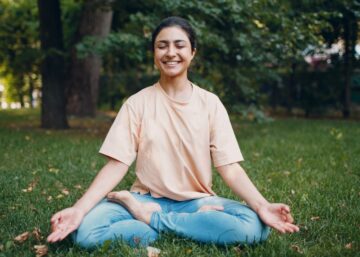In a fast-paced world that often leaves us feeling stressed and disconnected, the ancient practice of yoga emerges as a beacon of tranquility and holistic well-being. Originating in ancient India, yoga has transcended time and borders to become a global phenomenon celebrated for its physical, mental, and spiritual benefits. This article delves into the transformative power of yoga, exploring its diverse forms, health benefits, and the profound impact it can have on our daily lives.
The Essence of Yoga
Yoga, derived from the Sanskrit word “yuj,” meaning to yoke or unite, embodies the harmonious integration of mind, body, and spirit. At its core, yoga is not just a physical exercise; it is a lifestyle that seeks to cultivate balance and awareness in every aspect of life. The practice encompasses various forms, each catering to different needs and preferences.
1. Hatha Yoga: The Foundation
Hatha yoga, the most widely practiced form, focuses on physical postures (asanas) and breath control (pranayama). It provides a solid foundation for beginners, promoting flexibility, strength, and balance. Hatha yoga serves as a gateway to deeper practices, encouraging a mindful connection between movement and breath.
2. Vinyasa Flow: Dynamic Harmony
Vinyasa, often described as a “flow” practice, seamlessly links breath with movement. It offers a dynamic and creative sequence of postures, fostering cardiovascular fitness, agility, and mental focus. Vinyasa Flow is an exhilarating journey that encourages participants to synchronize their breath with a continuous series of poses.
3. Kundalini Yoga: Awakening the Energy Within
Kundalini yoga is a spiritual practice that aims to awaken the dormant energy at the base of the spine. Through a combination of dynamic movements, breathwork, and meditation, practitioners tap into their inner reservoir of vitality. Kundalini yoga is renowned for its transformative effects on both the physical and spiritual levels.
4. Ashtanga Yoga: Discipline and Strength
Ashtanga, meaning “eight limbs” in Sanskrit, is a rigorous and structured form of yoga. It follows a specific sequence of postures, promoting strength, flexibility, and endurance. Ashtanga demands discipline and regular practice, making it a transformative journey for those seeking physical and mental resilience.
The Physical Benefits of Yoga
1. Flexibility and Range of Motion
Regular practice of yoga postures enhances flexibility by lengthening and stretching muscles. Increased flexibility not only improves physical performance but also reduces the risk of injuries in daily activities.
2. Strength Building
Yoga utilizes body weight as resistance, fostering strength in various muscle groups. Poses such as plank, downward dog, and warrior sequences contribute to overall muscle tone and endurance.
3. Improved Posture
Yoga emphasizes body awareness and alignment, helping to correct poor posture. Strengthening the core muscles and promoting spinal flexibility contribute to a more upright and balanced posture.
4. Stress Reduction
The meditative aspect of yoga, combined with conscious breathing, activates the parasympathetic nervous system, reducing stress hormones and promoting a sense of calm. This holistic approach to stress management has far-reaching benefits for both mental and physical well-being.
The Mental and Emotional Benefits of Yoga
1. Mindfulness and Presence
Yoga encourages practitioners to be present in the moment, fostering mindfulness. The focus on breath and movement cultivates a heightened awareness that extends beyond the mat, promoting mental clarity and concentration.
2. Stress and Anxiety Relief
The practice of yoga has been shown to reduce the symptoms of stress and anxiety. Mindful breathing and relaxation techniques activate the body’s relaxation response, counteracting the negative effects of chronic stress.
3. Enhanced Emotional Well-being
Yoga provides a safe space for self-reflection and emotional release. The integration of physical movement with breathwork helps release pent-up emotions, promoting emotional resilience and balance.
4. Improved Sleep Quality
A regular yoga practice has been linked to improved sleep patterns. The calming effects on the nervous system, coupled with relaxation techniques, contribute to a more restful and rejuvenating sleep.
Yoga and Spirituality
Beyond its physical and mental benefits, yoga is deeply intertwined with spirituality. Many traditions view the practice as a path to self-realization and enlightenment. Whether through meditation, chanting, or the study of ancient texts, yoga provides a platform for individuals to explore and deepen their spiritual connection.
Incorporating Yoga into Daily Life
1. Establishing a Routine
Consistency is key when it comes to experiencing the full spectrum of benefits yoga has to offer. Setting aside dedicated time each day or week for practice establishes a routine that becomes a cornerstone of overall well-being.
2. Creating a Sacred Space
Designating a specific area for yoga practice, whether a corner of a room or a serene outdoor space, enhances the experience. A dedicated space serves as a reminder of the commitment to self-care and introspection.
3. Combining Yoga with Other Healthy Habits
Yoga complements other healthy lifestyle choices, such as a balanced diet and regular exercise. Integrating these elements creates a holistic approach to well-being that resonates throughout every aspect of life.
Overcoming Common Misconceptions
1. Age and Fitness Level
Contrary to common misconceptions, yoga is accessible to individuals of all ages and fitness levels. Modifications can be made to suit individual needs, making it an inclusive practice for everyone.
2. Time Constraints
One need not dedicate hours to experience the benefits of yoga. Short, consistent sessions can be just as impactful. Many practitioners find that even a brief daily practice yields noticeable improvements in physical and mental well-being.
Conclusion
In a world where the pace of life seems to accelerate continually, yoga emerges as a timeless sanctuary, offering a pathway to balance and self-discovery. As we explore the diverse realms of yoga, from the physical postures to the meditative practices, we find a holistic approach to health that extends beyond the mat. Embracing yoga as a way of life invites a transformative journey—one that harmonizes the body, mind, and spirit, paving the way for a more fulfilling and enriched existence. So, unroll your mat, breathe deeply, and embark on a journey of self-discovery through the ancient art of yoga. Namaste.







